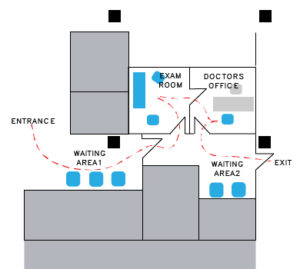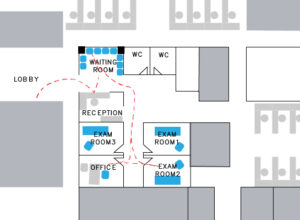How asset tracking and occupancy data can identify contamination risks, boost patient + doctor UX, while enabling CFOs and supply chains to monitor resource deployment in real time and evaluate efficiency in the long run.
Topics of discussion
- Understanding patient flow // Risk of contamination through circulation paths and adjacencies in waiting room
- Improve patient + doctor experience // Wait times, appointment time, total time spent
- Quantify supply + demand to make the space more efficient // Without accessing patient information, space allocation validated and optimized
Patients can be tracked in the facilities. This can be done anonymously by using Bluetooth beacons. This helps to understand patient flow and optimize the waiting time for everyone involved.
Patients often express frustration over long wait times and navigational confusion within healthcare facilities. Providers, on the other hand, become frustrated when patients are late for their appointments, or worse do not come to their appointment. The patient loses, and the clinic loses, no one wins the waiting game, but technology can help alleviate these issues.
Preface
While MySeat’s technology has most commonly been used in corporate office spaces, it can be deployed in any type of space where assets exist; retail, transportation, sporting venues and of course, healthcare.
Since 2016, when we completed our first project for a healthcare environment, demand for asset trackers has significantly increased. The current pandemic has us revisiting our asset tracking studies done for healthcare organizations to see what we learned from that data that can be useful to understand the current pandemic, as discussed in a previous release.
Wait time is the main metric in User Experience (UX) studies for walk-in services such as a medical office, however with an eye to current events, we also look at circulation patterns to reduce contamination risks, and optimizing space allocation for efficiency of resources.
In this paper we will be comparing data from two different studies conducted by our team in 2016 and 2019 respectively. First, a world-renowned research clinic in Jacksonville, Florida and more recently a private corporate in-house medical clinic in Montreal, Quebec.



1. Understanding patient flow
Waiting room usage, Circulation + High-touch surfaces
By identifying risk of contamination through circulation paths + waiting room crossovers, facility managers can make the space more hygienic.
Depending on the number of people waiting simultaneously, we can propose new layouts to optimize space utilization while maintaining distancing requirements.
Following the chronological anonymous data, we can trace the path of visitors through their visit, giving us insight to how users interact with spaces. This can identify potential contamination risks and improve layouts.
- To reduce contact or droplet transmission
- An increased spacing of waiting zones
- Directing circulation through the process of the visit, rather than to double back over areas by revising plan layouts



2. Understanding the UX
Improve patient + doctor experience by looking at the waiting times, appointment duration and the total time spent in the facility. Understanding the patient experience as well as the doctor’s workload is an important factor in evaluating your employee needs and the resources required to fulfill them.

3. Quantify supply + demand
Without needing to access confidential patient information, space + resource allocation is easily validated and optimized according to the results. In a case where the facility is presumed overloaded, the data can prove the capacity levels and unlock new resources, since the excessive demand can be easily documented accurately and anonymously. Equally, if the spaces are too generous for the usage, we can effectively determine which zones to reduce or reappropriate.
FINDINGS // Space utilization example
Out of all the patients that were seen by the doctor in Montreal.
- 47% used the main waiting area
- 18% used the secondary waiting area
- 35% didn’t use either space
RECOMMENDATIONS :
At the Research Clinic, the recommendation is to reduce number of seats in the waiting room, for better distancing between fellow patients. By adding tables between seats or removing some of the space dedicated. The layout could be optimized to include interconnected exam rooms and doctors offices, for clearer direct paths with no cross over of patients.
At the Corporate Clinic, the recommendation is to focus on a single waiting area instead of two.The client could re-purpose this space as an additional exam room, to isolate patients earlier in the process of the appointment.
Wellbeing in the workplace
MySeat has recently equipped other wellbeing spaces in workplace environments, illustrating firstly the increase in organisations that include wellbeing services and secondly, those that are questioning the return on investment of these sought-after employee amenities.
IoT allows to measure different KPIs that are pertaining to any type of space, so the space planner can enlighten their choice in terms of layout/equipment; and measure the impact on usage, waiting times, etc.
We know organizations care about their employees’ health and wellbeing. More and more often we are seeing them dedicating resources to building private gyms, in-house clinics, meditation spaces as well as access to on-site paramedical consultants such as nutritionists, psychologists and other specialties. If some of the CRE space should be used for health care, imagine the positive impact on organization, in terms of the efficiency of employee’s time, and not to mention, the crucial employee satisfaction levels.



